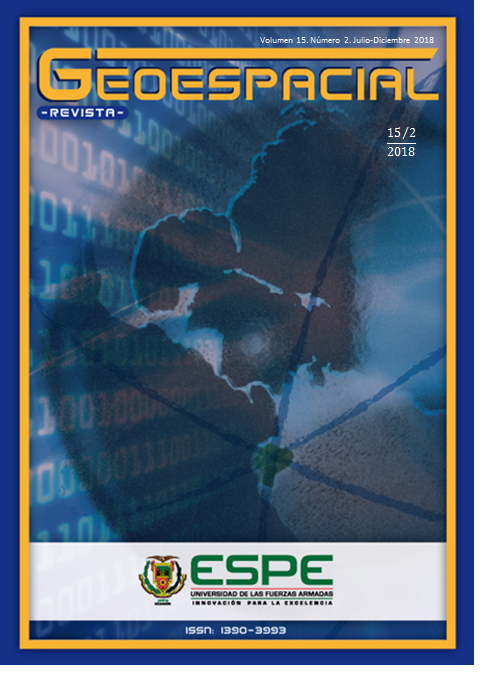PREDICTION OF PRECIPITABLE WATER VAPOR WITH A NEURAL NETWORK FROM THE ECUADORIAN GNSS AND METEOROLOGICAL DATA
##plugins.themes.bootstrap3.article.main##
摘要
El Sistema de posicionamiento global (GPS) consiste en una constelación de satélites que transmiten señales de radio a un gran número de usuarios en cuanto a navegación, transferencia de tiempo y posicionamiento relativo. Estas señales de radio de banda L se retrasan por el vapor de agua contenido en la atmosfera mientras viajan desde los satélites GPS a los receptores GPS en tierra. El vapor de agua desempeña un papel crucial en diferentes procesos atmosféricos, actuando en una amplia gama de escalas temporales y espaciales: desde el clima global hasta la micrometeorología. Los científicos han desarrollado una variedad de medios para medir la distribución vertical y horizontal del vapor de agua. En este trabajo, se estudió un modelo para la predicción del contenido de agua precipitable a partir de datos GNSS utilizando una red neuronal. En este caso, se estableció como parámetros iniciales: presión, temperatura, posiciones y retardo total del cenit; y en cuanto a la red neuronal fue una red neuronal de función base radial (RBFNN) con tres capas. Los resultados demostraron que el RBFNN logró predecir vapor de agua precipitable con un RMS hasta 2 mm en la red GNSS general, es decir, esta metodología es una alternativa valiosa para establecer un modelo para estas condiciones y parámetros.
##plugins.themes.bootstrap3.article.details##
Acceso a archivos
Los artículos publicados en la Revista Geoespacial se sujetan a las directrices de OPEN ACCES, en cuanto a la apertura de su contenido hacia todos los visitantes del sitio.
Derechos que conserva el autor:
El autor conserva los derechos morales de publicación
Cesión de derechos a autores:
Se cede los derechos de citas, referencias y temas relacionados con aspectos académicos y de investigación
##submission.howToCite##
参考
Bevis M., Businger S., Herring T., Rocken C., Anthes R. and Ware R. (1992). GPS meteorology: Remote sensing of atmospheric water vapor using the Global Positioning System. Journal of Geophysical Research, 97(D14), 15787-15801.
Böhm J., and Schuh H. (2013). Atmospheric effects in space geodesy (pp. 1-33). Berlin, Germany: Springer
Bordi I., Raziei T., Pereira L.S., and Sutera A. (2015). Ground-based GPS measurements of precipitable water vapor and their usefulness for hydrological applications. Water Resources Management, 29(2), 471-486.
Bordi I., Zhu X., and Fraedrich K. (2015). Precipitable water vapor and its relationship with the Standardized Precipitation Index: ground-based GPS measurements and reanalysis data. Theoretical and Applied Climatology, 1-13.
Broomhead D., and Lowe D. (1988). Multi-variable functional interpolation and adaptive networks. Complex Systems, 2, 321-355.
Chen S., Cowan C.F., and Grant P.M. (1991). Orthogonal least squares learning algorithm for radial basis function networks. Neural Networks, IEEE Transactions on, 2(2), 302-309.
Hagemann S., Bengtsson L., and Gendt G. (2003). On the determination of atmospheric water vapor from GPS measurements. Journal of Geophysical Research: Atmospheres (1984–2012), 108(D21).
Herring T.A., King R.W., Floyd M., and McClusky S. (2015). Introduction to GAMIT/GLOBK, Release 10.6. Available in Department of Earth, Atmostpheric and Planetetary Science at MIT. http://www-gpsg.mit.edu/.
Herring T.A. (1992). Modeling atmospheric delays in the analysis of space geodetic data. Proceedirws of Refraction of Transatmospheric simals in Geodesy, eds. JC De Munck and TA Spoelstra, Netherlands Geodetic Commission Publications on Geodesy, 36.
Kuo, Y. H., Zou, X., and Guo, Y. R. (1996). Variational assimilation of precipitable water using a nonhydrostatic mesoscale adjoint model. Part I: Moisture retrieval and sensitivity experiments. Monthly Weather Review, 124(1), 122.
Ladlani I., Houichi L., Djemili L., Heddam S., and Belouz K. (2012). Modeling daily reference evapotranspiration (ET0) in the north of Algeria using generalized regression neural networks (GRNN) and radial basis function neural networks (RBFNN): a comparative study. Meteorology and Atmospheric Physics, 118(3-4), 163-178.
MacMillan D.S., Ma C. (1994): Evaluation of very long baseline interferometry atmospheric modeling improvements. Journal of Geophysical Research: Solid Earth (1978–2012), 99(B1), 637-651.
Niell A.E. (1996). Global mapping functions for the atmosphere delay at radio wavelengths. Journal of Geophysical Research: Solid Earth (1978–2012), 101(B2), 3227-3246.
Nilsson T., Böhm J., Wijaya D.D., Tresch A., Nafisi V., and Schuh H. (2013). Path delays in the neutral atmosphere. In Atmospheric Effects in Space Geodesy (pp. 73-136). Springer Berlin Heidelberg.
Nistor S., and Buda A.S. (2015). Using Different Mapping Function In GPS Processing For Remote Sensing The Atmosphere. Journal of Applied Engineering Sciences, 5(2), 73-80.
Senkal O. (2015). Solar radiation and precipitable water modeling for Turkey using artificial neural networks. Meteorology and Atmospheric Physics, 1-8.
Xu W.B., Li Z.W., Ding X.L., and Zhu J.J. (2011). Interpolating atmospheric water vapor delay by incorporating terrain elevation information. Journal of Geodesy, 85(9), 555-564.
Zell A., Mache N., Hübner R., Mamier G., Vogt M., Schmalzl M., and Herrmann K.U. (1994). SNNS (Stuttgart Neural Network Simulator). In Neural Network Simulation Environments (pp. 165-186). Springer US.

